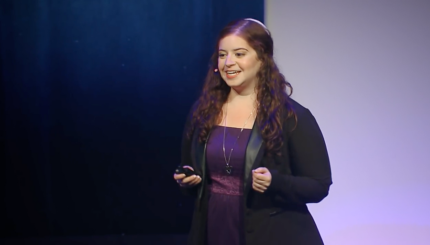In contemporary Jewish discourse, the term shekhinah most commonly refers to the divine feminine, or to the feminine aspect of God — God as mother, nurturer, protector and compassionate one. Though the term — from the Hebrew root meaning to “dwell” — is found throughout early rabbinic literature, in its early usage it referred generally to God’s presence among the people and had no gender associations. The connection between shekhinah and femininity emerges mainly in Jewish mystical literature. The concept was later embraced by Jewish feminists as a counterbalance to prevailing masculine notions of God as king, father and judge.
Early Appearances
The term shekhinah does not appear in the Hebrew Bible. The closest reference is two verses in Exodus in which God promises to dwell [v’shachanti] among the Israelites once they have built the tabernacle. (The Zohar, the core work of Jewish mysticism, would later associate the tabernacle, in Hebrew mishkan, with the shekhinah, both of which derive from the same Hebrew root.) The term shows up in a handful of places in the Mishnah, perhaps most famously in Pirkei Avot 3:2, which states that if two people sit together and share words of Torah, the shekhinah abides among them.
References to the shekhinah abound in the Talmud, some of them in similar aphorisms about various human activities that cause the divine presence to dwell amongst the people. Berakhot 6 says that the shekhinah is present when ten people pray, when three people come together to constitute a religious court, and when two people study Torah together. Menachot 43b teaches that anyone who is diligent in the mitzvah of tzitzit merits the shekhinah. And in a foreshadowing of the way the notion of the shekhinah would come to denote maternal comfort, Megillah 29a offers a series of textual interpretations that aim to show that the shekhinah accompanied the Israelites during their periods of exile.
The word also appears in some of the traditional Jewish liturgy, most notably the Jewish prayer for the dead, El Malei Rachamim, which asks God to provide the dearly departed true rest in the wings of the shekhinah.
With your help, My Jewish Learning can provide endless opportunities for learning, connection and discovery.
As Rabbi Leah Novick observed in her book On the Wings of Shekhinah: Rediscovering Judaism’s Divine Feminine, while the rabbis of the Talmud did not explicitly identify shekhinah as feminine, many of the attributes they ascribe to her are common to ancient goddesses: love, compassion, justice and healing.
This would continue in the medieval period. Maimonides made a handful of references to the shekhinah in his legal work the Mishneh Torah, writing for example that providing hospitality to travelers is greater than welcoming the shekhinah and that any meritorious rabbinic tribunal has the shekhinah residing with it. Likewise the 16th-century legal code the Shulchan Aruch, which states that when praying one should imagine the shekhinah standing before them.
Shekhinah in Kabbalah
Jewish mysticism, or Kabbalah, gives the shekhinah a distinctly female quality. One of the earliest works of Jewish mysticism, Sefer Habahir, states that when the righteous behave appropriately, “shekhinah rests among them, and through their deeds she rests in the bosom of the Holy One, and makes them fruitful and increases them.” The Zohar compares the shekhinah to a mother, sister, daughter and bride. Kabbalists also associated shekhinah with the clouds of glory, which guided the Israelites during their wandering in the desert, and the pillar of fire that warmed them at night. In this telling, the shekhinah is a protective maternal presence on the Israelites’ journey from slavery to freedom.
Kabbalistic cosmology is rooted in the notion that divine energy has masculine and feminine polarities that can be unified through human action. This idea is reflected in the ten sefirot, the emanations or attributes of divinity organized in the well-known image of the tree of life. Each of the sefirot has a masculine or feminine quality and a counterpart on the opposing side of the tree. Shekhinah is associated with malchut (kingship), the lowest of the sefirot and the intermediary between the upper emanations and the material world, the recipient of the divine energy flowing from above just prior to its manifestation in physical reality. In some accounts, this makes shekhinah the closest sefirah to the material world and the part of divinity most readily experienced in nature.
The idea of the shekhinah as the counterpart to the masculine element of God is, according to the Kabbalah scholar Gershom Scholem, one of Jewish mysticism’s most significant innovations. “The fact that it obtained recognition in spite of the obvious difficulty of reconciling it with the conception of the absolute unity of God, and that no other element of Kabbalism won such a degree of popular approval, is proof that it responded to a deep-seated religious need,” Scholem wrote.
Jewish Feminism
That need would become readily apparent with the rise of the Jewish feminist movement in the 20th century. Because Kabbalah was a largely hidden tradition for much of Jewish history, these associations between shekhinah and femininity were largely kept out of mainstream Jewish thought. But feminist Jewish leaders, eager to counter the default masculine conception of God, and assisted by the mainstreaming of Kabbalah itself, helped bring the concept of shekhinah into popular consciousness.
“Just as Shekinah has been in exile, so Jewish women have been in exile,” Rabbi Lynn Gottlieb wrote in her 1995 feminist tract She Who Dwells Within, its title essentially a literal translation of shekhinah.”
By the turn of the 21st century, it was no longer unusual to find voices within the liberal Jewish movements specifically invoking shekhinah in prayer and ritual. This is particularly pronounced in the Jewish Renewal movement, which draws heavily on kabbalistic imagery and metaphor but is resolutely committed to gender egalitarianism. Siddur haKohanot: A Hebrew Priestess Prayerbook, co-authored by the feminist rabbi and theologian Jill Hammer, uses shekhinah liberally to refer to God.
“There is a growing interest in Jewish culture in the image of Shekhinah as a feminine complementary or substitute for the more widespread images of God,” Bar Ilan University lecturer Leore Sachs-Shmueli observed in a 2019 paper. “This quest for the image of Shekhinah grew as theological sensitivity to gender aspects of the images of God brought many feminists to feel uncomfortable with more traditional and patriarchal images of God as king, father, and Lord.”
Hasidic
Pronounced: khah-SID-ik, Origin: Hebrew, a stream within ultra-Orthodox Judaism that grew out of an 18th-century mystical revival movement.



